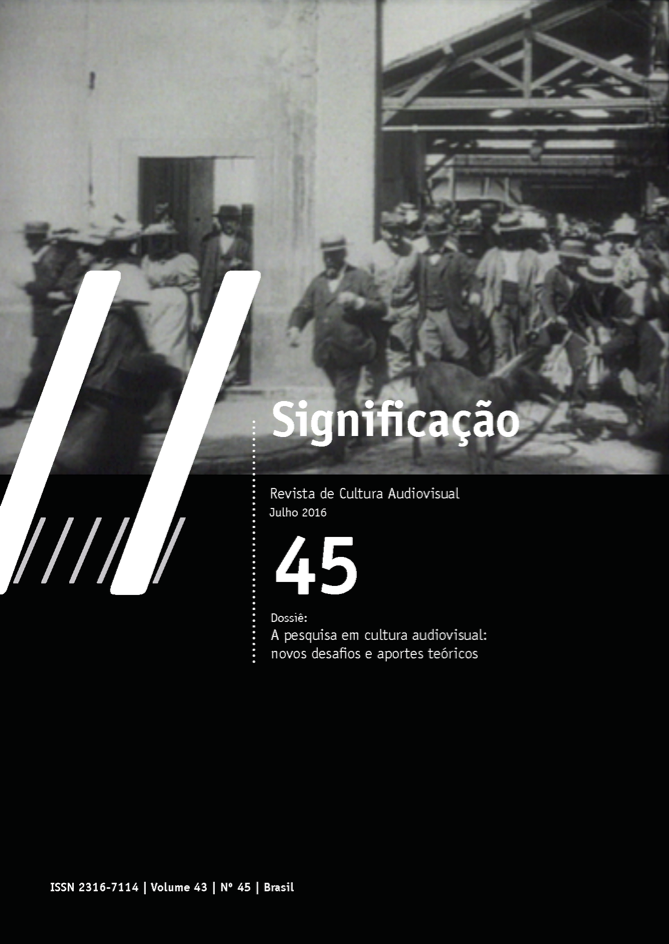The past and its point of departure. A review of A luta armada no cinema: ficção, documentário, memória, by Fernando Seliprandy
DOI:
https://doi.org/10.11606/issn.2316-7114.sig.2016.108458Keywords:
Brazilian cinema, military dictatorship, armed struggle, Bruno Barreto, Silvio Da-RinAbstract
A luta armada no cinema: ficção, documentário, memória compares two films about the same historical event: the kidnapping of American ambassador Charles Elbrick in 1969 by the Revolutionary Movement 8th October (MR-8) and the National Liberation Alliance (ALN). Through four chapters, Fernando Seliprandy interrogates both the “historical fiction” O que é isso, companheiro? (Bruno Barreto, 1997) and the “documentary” Hércules 56 (Silvio Da-Rin, 2006), in a serious work. The author proposes an original treatment of the strategies used by both films; of the oppositions created by the two narratives; of the “past” that each one of them recreates; and of the possible relations between the images of memory and the context where they were producedDownloads
References
BENJAMIN, W. “Escavar e lembrar”. In. Obras escolhidas, v. 2. São Paulo: Brasiliense, 1987, p. 239. “Fouilles et souvenir”. In. Images de pensée. Paris, Christian Bourgeois, 1998.
COMISIÓN NACIONAL SOBRE LA DESAPARICIÓN DE PERSONAS. Nunca más: informe de la Conadep. 8a. Ed.. Buenos Aires: Eudeba, 2011.
CURRIE, G. “Ficções visuais”. In. RAMOS, F. P. (org.), Teoria contemporânea do cinema: pós-estruturalismo e filosofia analítica, vol. 1, São Paulo: Editora do Senac, 2005.
FERRO, M. “O filme: uma contra-análise da sociedade?”. In. Cinema e história, 2a ed. São Paulo: Paz e Terra, 2010.
GABEIRA, F. O crepúsculo do macho. 13a. ed. Rio de Janeiro: Codecri, 1980.
____________. O que é isso, companheiro? São Paulo: Cia. das Letras, 1997.
GASPARI, E. A ditadura envergonhada. São Paulo: Cia. das Letras, 2002.
___________. A ditadura escancarada. São Paulo: Cia. das Letras: 2003.
___________. A ditadura encurralada. São Paulo: Cia. das Letras: 2004.
NINEY, F. L’épreuve du réel à l’écran: essai sur le príncipe de réalité documentaire. Bruxelas: De Boeck, 2000.
ODIN, R. “Film documentaire, lecture documentarisante”. In. LYANT, J. C. (ed.), Cinémas et réalités. Saint-Etienne: Université de Saint-Etienne, 1984, p. 263-278.
RAMOS, F. Mas afinal... o que é mesmo o documentário? São Paulo: Editora Senac, 2008.
REIS FILHO, D. A. A revolução faltou ao encontro: os comunistas no Brasil. São Paulo: Editora Brasiliense, 1990.
________________. “Versões e ficções: a luta pela apropriação da memória”. In. REIS FILHO, D. A. et al. Versões e ficções: o sequestro da história. São Paulo: Editora Fundação Perseu Abramo, 1997, p. 102-103.
RICOEUR, P. A memória, a história, o esquecimento. Campinas: Editora da Unicamp, 2007.
_________. Temps et récit. Paris: Éditions du Seuil, 1983, tomo 1.
SELIPRANDY, F. A luta armada no cinema: ficção, documentário, memória. São Paulo: Intermeios, 2015.
WALTON, K. Mimesis as Make-Believe: on the Foundations of the Representational Arts (Cambridge: Harvard University Press, 1990).
___________. “Temores fictícios”. In. RAMOS, F. P. (org.), Teoria contemporânea do cinema: pós-estruturalismo e filosofia analítica, vol. 1, São Paulo: Editora do Senac, 2005.
VEYNE, P. Comment on écrit l’histoire, Paris, Seuil, 1971.
Downloads
Published
Issue
Section
License
Copyright (c) 2016 Lúcia Ramos Monteiro

This work is licensed under a Creative Commons Attribution-NonCommercial 4.0 International License.
Authors who publish in this journal must agree with the following terms:
- Authors keep their copyrights and grant the journal first time publication rights, having their articles simultaneously licensed under the Creative Commons Attribution License, which allows sharing texts with authorship recognition and first publication on this journal for non-commercial purposes.
- Authors are allowed to make additional contracts, for a non-exclusive distribution of the article’s version published on this journal (e.g.: publishing in institutional repositories of articles or as a book chapter), with authorship recognition and first publication on this journal.
















